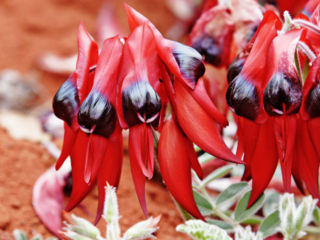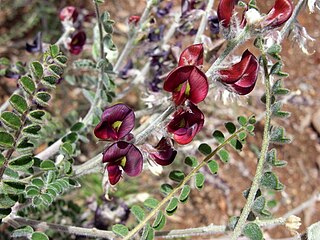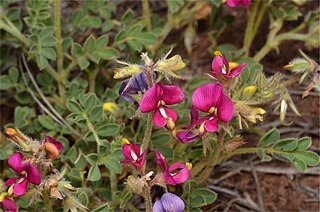
Swainsona formosa, commonly known as Sturt's desert pea or Sturt pea, is a species of flowering plant in the family Fabaceae and is native to all continental states and the Northern Territory of Australia, with the exception of Victoria. It is a prostrate annual or short lived perennial herb with imparipinnate leaves with about 15 elliptic to egg-shaped leaflets with the narrower end towards the base, and racemes of usually red flowers in racemes of 2 to 6.

Swainsona is a genus of about 85 species of flowering plants in the family Fabaceae, and is endemic to Australia. Plants in this genus are herbs or subshrubs with imparipinnate leaves and usually purple flowers similar to others in the family.

Swainsona galegifolia commonly known as smooth Darling pea, is a species of flowering plant in the family Fabaceae and is endemic to Australia. It is a small shrub with greyish-green leaves and flowers in white, red, pink, purple, yellow or orange.

Swainsona colutoides, commonly known as bladder senna or bladder vetch, is a species of flowering plant in the family Fabaceae and is endemic to arid areas of Australia. It is an erect annual, shrub-like herb, with imparipinnate leaves usually with up to 13 to 17 egg-shaped leaflets with the narrower end towards the base, and racemes of 10 to 20 purple flowers.

Swainsona brachycarpa, commonly known as slender swainson-pea, is a species of flowering plant in the family Fabaceae and is endemic to eastern Australia. It is a prostrate or ascending perennial herb with imparipinnate leaves usually with 9 to 13 egg-shaped to narrowly elliptic or egg-shaped leaflets, and racemes of up to 12 white, purple or dark red flowers.
Swainsona bracteata is a species of flowering plant in the family Fabaceae and is endemic to eastern Australia. It is a perennial herb with imparipinnate leaves usually with 19 to 25 narrowly egg-shaped leaflets, and racemes of about 20 white, pale pink or pale purple flowers.

Swainsona burkittii, commonly known as woolly Darling pea, is a species of flowering plant in the family Fabaceae and is endemic to inland Australia. It is an erect or low-lying perennial with imparipinnate leaves usually with 15 to 30 egg-shaped to more or less circular leaflets, and racemes of up to fifty dark reddish-purple flowers.

Swainsona campylantha, commonly known as Gilgai Darling pea, is a species of flowering plant in the family Fabaceae and is endemic to inland areas of Australia. It is a low-growing perennial with imparipinnate leaves usually with up to 7 narrowly lance-shaped to narrowly elliptic leaflets, and racemes of 2 to 10 pink to purple flowers.
Swainsona cyclocarpa is a species of flowering plant in the family Fabaceae and is endemic to northern inland areas of Australia. It is a prostrate or low-growing annual with imparipinnate leaves usually with up to 7 usually egg-shaped leaflets with the narrower end towards the base, and racemes of 4 to 16 purple flowers.
Swainsona decurrens is a species of flowering plant in the family Fabaceae and is endemic to northern inland areas of Australia. It is an erect annual with imparipinnate leaves usually with 15 to 19 narrowly elliptical leaflets and racemes of 20 to 30 red or purple flowers.
Swainsona disjuncta is a species of flowering plant in the family Fabaceae and is endemic to widely separated areas of central Australia. It is a prostrate perennial herb with imparipinnate leaves with 3 to 9 egg-shaped leaflets, and racemes of purple, pink or red flowers in racemes of 3 to 15.

Swainsona elegans is a species of flowering plant in the family Fabaceae and is endemic to Western Australia. It is a prostrate or ascending annual with imparipinnate leaves, usually with 7 to 15 egg-shaped or elliptic leaflets, and racemes of up to 15 blue or reddish-purple flowers.
Swainsona eremaea is a species of flowering plant in the family Fabaceae and is endemic to South Australia. It is a low-growing, spreading, probably perennial plant with imparipinnate leaves with 5 to 11 linear, oblong to broadly wedge-shaped leaflets, and racemes of bright red to brown or yellow flowers in racemes of 5 to 20.
Swainsona extrajacens is a species of flowering plant in the family Fabaceae and is endemic to central Australia. It is an erect, annual plant with imparipinnate leaves with 9 to 21 linear, egg-shaped leaflets, and racemes of purple flowers in racemes of 5 to 10.
Swainsona fissimontana is a species of flowering plant in the family Fabaceae and is endemic to inland areas of southern continental Australia. It is a compact, erect or upright perennial herb with imparipinnate leaves with 7 to 13 narrowly elliptic to elliptic leaflets, and racemes of pink to dark purplish flowers in racemes of 3 to 11.

Swainsona flavicarinata is a species of flowering plant in the family Fabaceae and is endemic to inland areas of continental Australia. It is a prostrate to more or less erect perennial herb, with imparipinnate leaves with 5 to 9 egg-shaped leaflets with the narrower end towards the base, and racemes of purple, red or pink flowers in racemes of 3 to 15.
Swainsona forrestii is a species of flowering plant in the family Fabaceae and is endemic to the central northern Western Australia. It is an erect or spreading, single-stemmed annual herb, with imparipinnate leaves with about 13 to 17 narrowly egg-shaped or narrowly ellipitic leaflets, and racemes of dark brownish red to purple or pink flowers in racemes of 30 or more.
Swainsona fraseri is a species of flowering plant in the family Fabaceae and is endemic to eastern Australia. It is a perennial plant with imparipinnate leaves with mostly 21 to 24 ellipitic leaflets, and racemes of 20 or more pink to purple flowers.
Swainsona fuscoviridis is a species of flowering plant in the family Fabaceae and is endemic to South Australia. It is a perennial plant with many stems and imparipinnate leaves with mostly 7 or 9 ellipitic, linear or egg-shaped or lance-shaped leaflets, and racemes of 12 to 20 purple flowers.
Swainsona gracilis is a species of flowering plant in the family Fabaceae and is endemic to the south-west of Western Australia. It is a prostrate or ascending perennial herb with imparipinnate leaves with up to 15 wedge-shaped or narrowly oblong leaflets, and racemes of up to 4 purple or blue flowers.









